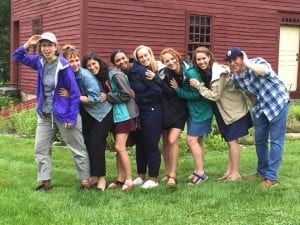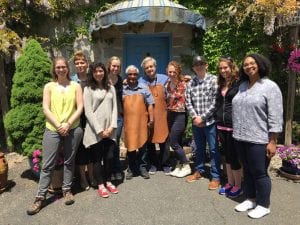The WPAMC Experience: 5 from 5 in 5
By RJ Lara, WPAMC Class of 2019
WPAMC Fellows are fortunate in that we get to do a considerable amount of traveling over our two years in the program. Each cohort journeys on 4 formal field studies—England, Southeastern U.S., Northeastern U.S., and New York City—that take us to approximately 100 different institutions, historic sites, businesses, and private homes. Sprinkled in between these field studies are other day trips and weekend voyages, part of our semesterly coursework for classes like Connoisseurship of the Decorative Arts and Craftsmanship in Early America. My cohort, the Class of 2019, traveled from London to Stoke-on-Trent, Bristol, and Bath. We have also journeyed through 12 of the 50 states together, and I am grateful for all the friendships that our experiences have forged—sometimes literally with hammer in hand. Here are my 5 favorite sites from 5 field studies in (about) 500 words.
England Trip: Hampton Court Palace (East Molesey, Surrey)

One of the Pond Gardens at Hampton Court Palace. William III and Mary II’s Banqueting House stands behind the garden. Photograph courtesy of author.
I had never visited a British royal residence until Hampton Court Palace, and the experience blew me away. It was a crisp, cold day and the wind howled down the Tudor brickwork corridors. We had two extraordinary museum professionals show us around: Marc Meltonville, Food Historian at the Historic Royal Palaces, and Sebastian Edwards, Historic Royal Palaces’ Deputy Chief Curator and Head of Collections. The palace’s decorative arts collection and amalgamated Tudor and Baroque structures were impressive enough, but the beauty and complexity of the gardens in the dead of winter solidified the site as my favorite on our England Trip. Sebastian and Marc were also kind enough to treat my class to a tour of the Antonio Verrio painted interior of William III and Mary II’s circa 1700 Banqueting House (visible in the back right of the above photo).
Southern Trip: Drayton Hall (Charleston, South Carolina)

View from Drayton Hall’s front portico, looking southwest. Photograph courtesy of author.
This was another site in which our hosts and the pure beauty of the landscape made the whole experience memorable. Drayton Hall had just finished constructing their Sally Reahard Visitor Center when we arrived, and it was there that we received a wonderful welcome and tour from Trish Lowe Smith, Curator of Historic Architectural Resources, and Carter Hudgins, President and CEO. The history of Drayton Hall also made the site stand out from others on our trip. In the above photo you are standing on Drayton’s grand front portico, overlooking a rice plantation that was sustained by the work of enslaved individuals from the house’s construction in the mid-1700s until the abolishment of slavery. Furthermore, Drayton Hall’s ‘Preserve as Found’ interpretation is exceptional.
Instagram: @draytonhall
Northern Trip: Hurd House (Woodbury, Connecticut)

WPAMC Class of 2019 posing in front of the Hurd House. From left to right: Eliza, Kate, Brooke, Elizabeth, Katie, Carrie, Alexandra, and RJ. Photograph courtesy of WPAMC.
In the late 1700s, John Hurd built the earliest section of what is now known as the Hurd House in the small town of Woodbury. Other sections were subsequently added onto the house, and by the 19th century, the clapboard-sided structure was the family home of someone close to the Winterthur Museum (sorry, I do not want to ruin the surprise for future classes). The site was made that much more special through personal memories about time spent on the property and stories about family members who lived in the house. Plus, my class had fun recreating a historic Hurd House photo! Our rendition is above.
New York City Trip: Museum at Eldridge Street and the Eldridge Street Synagogue

The interior of Eldridge Street Synagogue. Kiki Smith’s circular window was installed in 2010. Photograph courtesy of author.
My cohort visited three synagogues over the course of two field studies. On the Northern Trip, we visited Touro Synagogue in Newport, Rhode Island and Vilna Shul in Boston, Massachusetts. In New York City in January, we visited the Eldridge Street Synagogue. Each place of worship was incredible in its own right. The Eldridge Street Synagogue’s interior was particularly striking. Years of tireless restoration brought the painted walls and pews back to their original character, and the synagogue is appropriately lit using historically accurate, yet modern-manufactured light bulbs. Arguably the most striking feature is the large, circular window that was designed by Kiki Smith and installed in 2010. The contemporary piece’s addition to the historic interior celebrates the revitalization of the building in the 21st century.
Instagram: @museumateldridgestreet
Connoisseurship Trip: Ubaldo Vitali (Maplewood, New Jersey)

WPAMC Class of 2019 standing in front of Ubaldo Vitali’s silversmithing shop. From left to right: Eliza, Kate, Brooke, Katie, Amrit Tamrakar, Ubaldo Vitali, Carrie, RJ, Alexandra, and Elizabeth. Photograph courtesy of Ann Wagner.
Ubaldo Vitali. Master silversmith. Alchemist. Philosopher. MacArthur ‘Genius Grant’ recipient. We visited Mr. Vitali’s shop during our Metals Block. The outing was one of my favorite day trips during our 7 Connoisseurship courses. Ubaldo’s silversmithing skills are unrivaled, and his knowledge of the materials of his trade is exceptional. The kindness with which he invited us through his workshop and his sincere interest in our own work was even more impressive. I’ll never forget it.
Extra-Curricular: Dublin Castle (Dublin, Ireland)

The interior of the Portrait Gallery at Dublin Castle. The ceiling is ornamented with beautiful plasterwork. Photograph courtesy of author.
Okay, I lied. I am adding one last site that was actually a bit of extra-curricular travel. On our one free day during our England Trip I flew to Dublin. Aside from Trinity College’s campus and the National Gallery of Ireland, the unexpected highlight was visiting Dublin Castle: the seat of British rule in Ireland from 1204 until 1922. The connections I noticed between Irish craftspersonship, English imperial influence, and British design history as it related to early America were beyond my wildest material culture dreams. It was a valuable adventure.
Thank you to my cohort—Brooke Baerman, Kate Budzyn, Katie Fitzgerald, Carrie Greif, Elizabeth Humphrey, Alexandra Rosenberg, and Eliza West—for the lifetime of memories!

Leave a Reply